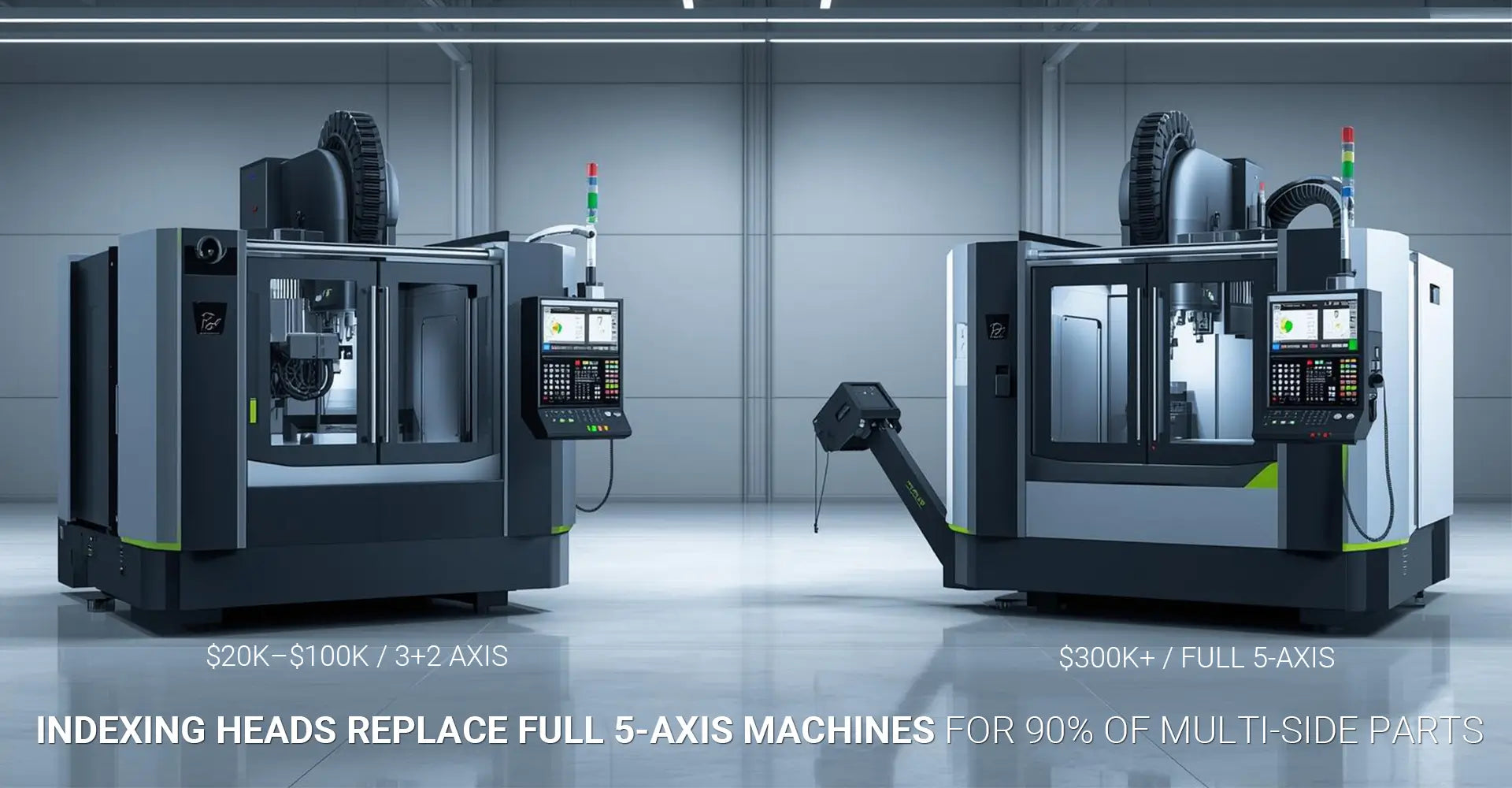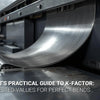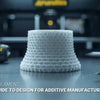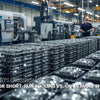Can Indexing Heads Replace Full 5-Axis Machines for 90% of Multi-Side Parts?

Can Indexing Heads Replace Full 5-Axis Machines for 90% of Multi-Side Parts?

Manufacturers facing complex parts often assume they need expensive full 5-axis machines. However, indexing heads offer a compelling alternative that delivers multi-sided machining capabilities at a fraction of the cost. This breakthrough approach can handle up to 90% of parts requiring angled features while saving significant capital investment. Furthermore, these solutions integrate seamlessly with existing CNC machining service operations without requiring complete facility overhauls.
Quick Answer: Indexing heads enable 3+2 axis machining on standard CNC mills, providing multi-side access for $20,000 versus $300,000+ for full 5-axis machines. While they can't machine continuous curves, they excel at parts with angled holes, multiple faces, and precision features. Additionally, this low cost 5 axis solution maintains the quality standards expected in professional manufacturing environments.
Before diving into the technical details and cost comparisons, let's explore how this technology works and when it makes the most sense for your production needs. Moreover, understanding the fundamental differences will help you make informed decisions about expanding your machining capabilities.
Table of Contents
- What Makes Indexing Heads Different from Full 5-Axis Machines?
- How Much Can You Actually Save with 3+2 Axis Solutions?
- Which Parts Work Best with Indexing Head Technology?
- Is Programming an Indexing Head Really That Simple?
What Makes Indexing Heads Different from Full 5-Axis Machines?
Understanding the fundamental difference between indexing heads and simultaneous 5-axis machines is crucial for making the right investment decision. While both technologies provide multi-axis capabilities, their approaches and applications differ significantly. Consequently, manufacturers must evaluate their specific needs before committing to either solution.
Key Difference: Indexing heads position parts at fixed angles for 3-axis machining (3+2), while full 5-axis machines can cut while all axes move simultaneously. This creates distinct advantages and limitations for each approach. In fact, this positional 5th axis methodology proves sufficient for most manufacturing applications.
Indexing heads mount to your existing 3-axis CNC mill table, rotating workpieces to precise angles before locking in place. This process, known as indexed machining, allows access to multiple part faces without manual repositioning. Meanwhile, full 5-axis machines maintain continuous motion across all axes, enabling complex sculptured surfaces but requiring significantly more investment. The choice depends on your part geometry and production requirements. Additionally, when considering trunnion table vs full 5 axis configurations, indexing heads offer the flexibility of both approaches at reduced complexity. These systems work particularly well with various industrial machinery setups already in place.
How Much Can You Actually Save with 3+2 Axis Solutions?
The financial impact of choosing indexing heads over full 5-axis machines extends far beyond initial purchase price. Total cost of ownership includes training, programming, maintenance, and operational expenses that compound over time. Therefore, manufacturers should evaluate long-term financial implications rather than focusing solely on upfront costs.
Cost Breakdown: Adding an indexing head to a 3-axis machine typically costs $100,000 total versus $200,000-$500,000 for full 5-axis capability. Additional savings include reduced programming time, lower training costs, and simplified maintenance requirements. This analysis directly addresses indexing head 5 axis machining cost concerns that many manufacturers face.
Beyond the substantial upfront savings, indexing heads require less specialized programming knowledge than simultaneous 5-axis operations. Your existing 3-axis programmers can quickly adapt to 3+2 operations, eliminating expensive training programs. Additionally, maintenance costs remain lower since you're essentially adding a rotary table CNC component to proven 3-axis technology. Floor space requirements also stay minimal compared to larger 5-axis machines. Furthermore, this cost-effective multi-axis approach allows businesses to expand capabilities without massive facility renovations or extended downtime periods.
Which Parts Work Best with Indexing Head Technology?
Identifying the right applications for indexing heads determines project success and cost-effectiveness. Certain part geometries benefit tremendously from 3+2 machining, while others require full simultaneous motion. Understanding these distinctions helps manufacturers maximize their investment returns while maintaining quality standards.
Ideal Applications: Parts with angled holes, multi-sided features, bolt circles, gear teeth, and orthogonal surfaces work perfectly with indexing heads. Complex sculptured surfaces requiring continuous motion need full 5-axis capability. These applications demonstrate the CNC indexing head benefits across various manufacturing sectors.

Indexing heads excel at aerospace brackets with angled bolt patterns, automotive prototypes requiring multi-sided machining, and fixture components with precise angular relationships. The technology handles any part where cutting occurs at fixed angles rather than requiring continuous sculptured motion. Consider your part library: if 80-90% involves angled features rather than flowing surfaces, indexing heads likely provide the capability you need at significant savings. These solutions work exceptionally well with various CNC metals plastics materials while maintaining precision requirements. Additionally, this milling machine attachment approach provides versatility for manufacturers working with diverse material types and part geometries.
Is Programming an Indexing Head Really That Simple?
Programming complexity often determines whether new technology gets adopted successfully in production environments. Indexing heads offer a gentler learning curve compared to full 5-axis programming requirements. Consequently, manufacturers can implement these solutions faster with existing personnel rather than hiring specialized programmers.
Programming Reality: Indexing heads use standard 3-axis programming with simple rotational commands (like G0 A90.0). Most CAM software automatically generates indexed toolpaths, making the transition straightforward for existing programmers. This simplicity showcases how 3+2 axis machining integrates smoothly into established workflows.

Unlike complex 5-axis programming requiring specialized training and advanced CAM packages, indexing head programming builds on existing 3-axis knowledge. Programmers simply add rotational positioning commands between standard milling operations. Popular CAM systems like Mastercam, Fusion 360, and others include built-in indexing strategies that automatically position parts and generate collision-free toolpaths. This accessibility means faster implementation and reduced learning curves. Moreover, the consistent surface finish quality achievable through indexed positioning often exceeds manual setup results while reducing operator skill requirements.
Conclusion
Indexing heads provide a practical pathway to multi-sided machining without the complexity and cost of full 5-axis systems.
For manufacturers evaluating multi-axis capabilities, indexing heads offer compelling value for parts requiring angled features and multi-sided access. While they can't replace full 5-axis machines for every application, they handle the majority of complex parts at substantial savings. The combination of lower investment, simplified programming, and proven reliability makes indexing heads an intelligent choice for expanding machining capabilities. Consider your current part mix and future needs when evaluating this cost-effective path to advanced manufacturing. Ultimately, this technology bridges the gap between basic 3-axis operations and full 5-axis complexity while maintaining the precision and quality standards that modern manufacturing demands.
[External Links Recommendation]
[indexing head][^1]
[3+2 axis machining][^2]
[trunnion table vs full 5 axis][^3]
[CNC indexing head benefits][^4]
---
[^1]: Learn about the functionality of indexing heads and their role in precision machining processes.
[^2]: Explore this link to understand the advantages and applications of 3+2 axis machining in modern manufacturing.
[^3]: Learn about the advantages and applications of trunnion tables compared to full 5 axis systems.
[^4]: Discover how CNC indexing heads can enhance precision and efficiency in machining processes.
[^5]: Understanding the positional 5th axis can enhance your machining capabilities and precision, making it a valuable resource for manufacturers.





